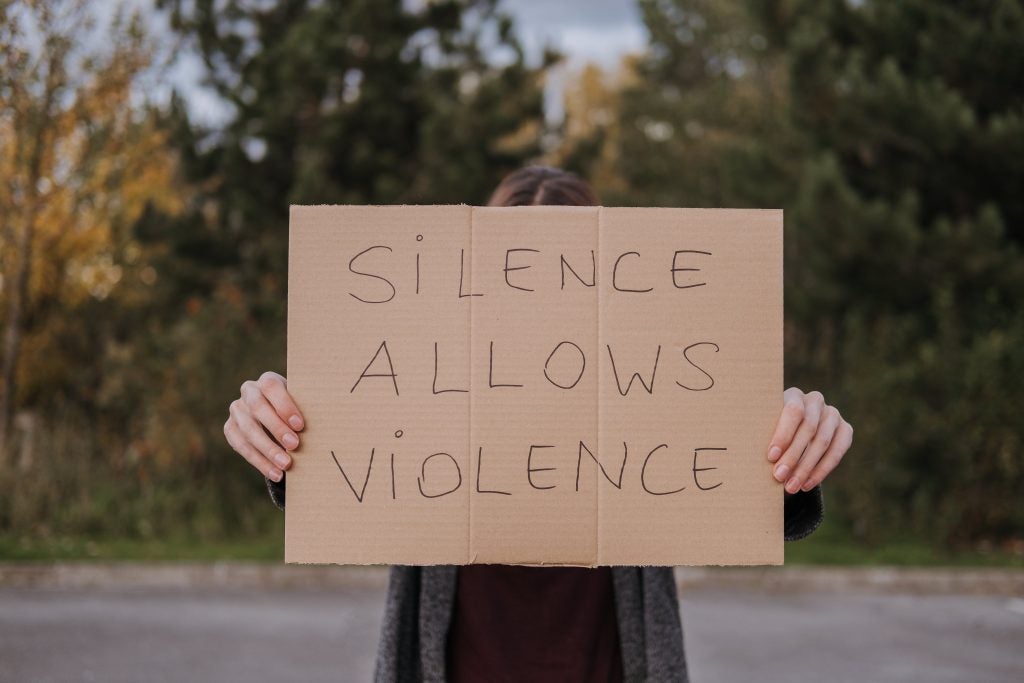Disclaimer: We acknowledge that there are many different words that individuals use to describe themselves after experiencing sexual assault. In this article, we use the term “survivor” for the sake of consistency. We acknowledge that there are many ways of processing abuse, and we believe that each individual person should choose the language that they are most comfortable with.

Abuse is something that affects all kinds of people all over the world. There is more than one way to experience abuse; some forms include physical abuse, sexual abuse, psychological abuse, emotional abuse, digital abuse, and more. Anyone can be an abuser, and anyone can experience abuse. Abuse, in any form, is always serious and should never be tolerated under any circumstances. If you or a loved one need help, there are resources available at the end of this article.
Definition of Abuse
Abuse is defined as “a pattern of behavior used by one person to gain and maintain power and control over another.”¹ It is important to pay attention to the fact that abuse is a pattern of behaviors, not just a single occasion. Abuse can take on many different forms and often consists of much more than just physical violence. Unfortunately, many people only think of the physical aspect of maintaining power and control, when in reality abuse can look very different for some people.¹ There are many warning signs of an abusive relationship. Some of these signs include the following:
- Extreme jealousy: an abuser may be overprotective, make false accusations, and/or be jealous when the survivor spends time with other people.⁸
- Controlling behavior: the abuser may keep constant tabs on the survivor, make all the decisions in the relationship, control all finances, etc.⁸
- Isolation: the abuser may try to keep the survivor away from family and friends.⁸
- Hypersensitivity: an abuser may blow things out of proportion, be quick to anger, and have mood swings.⁸
There are many more warning signs; these are just a few of the possible signals. If you see any of these signs in your or a loved one’s relationships, you may wish to seek help.
An abuser can be your partner, family member, friend, coworker, or anyone you have a relationship with. Fearing someone or feeling as if you must constantly cater to their needs are some of the more obvious signs that you may be in an abusive relationship.2 By learning the characteristics of the different forms of abuse, you can learn to recognize the indicators if you or someone you know is being abused so that you can seek help.
Types of Abuse
There are several different forms of abuse that a perpetrator may exercise on a survivor, and the survivor may experience one or more of them. The following includes examples of different forms of abuse:
- Physical abuse
- Psychological abuse
- Emotional abuse
- Sexual abuse
- Financial abuse
- Spiritual abuse
- Verbal abuse
- Digital abuse
- Neglect
Physical Abuse

Physical abuse is defined as “intentional bodily injury; this may include slapping, pinching, choking, kicking, shoving, using a weapon, etc. to intimidate a person or maintain control.⁶ This is usually the most recognizable form of abuse because there may be visible evidence of violence on the survivor, such as bruises or scabs; however, a survivor does not need to have any visible signs of abuse for it to be considered physical abuse. Nearly 20 people per minute are physically abused by a partner in the United States, which equates to more than ten million people per year.⁴ In fact, partner violence accounts for 15% of all reports of violent crime in the United States.⁴ Physical abuse is a crime in the U.S. and many other countries; the police have the authority to protect a person from a physical attack, and there are several ways to report an abuser.⁷ Physical abuse is incredibly dangerous for the survivor, putting them more at risk for chronic health issues, mental health issues, serious injury, and even death.⁷
Psychological Abuse
Psychological abuse is when an abuser wears down on a survivor’s sense of mental health and wellbeing through certain words or actions.¹ This form of abuse is widespread; 48.4% of US women and 48.8% of US men have experienced at least one psychologically aggressive experience with a partner.⁴ Psychological abuse is often used to force the abused person to cooperate with the abuser. Often, the abuser will make the survivor question their own sanity through manipulation tactics like gaslighting.¹ For example, an abuser may twist facts or flat out deny that certain events have happened.¹ Shaming and humiliation are also common forms of psychological abuse. Psychological abuse can have serious effects on the survivor’s physical and mental health, including chronic pain, anxiety, depression, and post-traumatic stress disorder.⁷
Emotional Abuse
Emotional abuse may consist of verbal attacks, humiliation, breaking one’s possessions, or any actions that cause loss of self-esteem.2 This includes insults, name-calling, swearing, or criticizing. Emotional abuse is the most common form of abuse, but it can be very difficult to spot because it does not cause visible injury. The abuser may try to put down the survivor and make it seem like their own actions are the survivor’s fault.2 Emotional abuse is often a component of other forms of abuse; for example, a psychological abuser may inflict emotional abuse to further manipulate their partner. These negative outbursts tend to be linked with jealousy, distrust, anger, and accusations.2
Sexual Abuse

Sexual abuse is “any behavior that pressures or coerces someone to do something sexually that they don’t want to do.”2 This can include unwanted kissing or touching, unwanted rough or violent sexual activity, refusing to use or restricting access to birth control and STI protection, threatening, sexual insults, engaging in sexual activity when someone is under the influence of drugs or alcohol, or is unconscious, and more.2 Sexual abuse can also be called rape or sexual assault. Sexual abuse can happen between friends, strangers, family members, dating couples, and even married couples.2 In fact, almost 50% of all reported rape victims in the U.S. were assaulted by someone they knew, and of these, 45.4% of female and 29% of male rape survivors were assaulted by an intimate partner.⁴ Not all sexual abuse is a violent attack, and sexual abuse is never the survivor’s fault in any way. Everyone has the right to control their own body. The only time sexual contact is not sexual assault is when both partners have received clear, affirmative consent from their partner. Consent is defined as “an agreement between participants to engage in sexual activity” and should always be clearly and freely communicated.⁹ Consent can be revoked at any point, and it is up to the person initiating the sexual activity to be sure their partner has given full consent at all points during sexual activity.⁹
Financial/Economic Abuse
Financial and economic abuse occurs when an abuser takes control of the survivor’s finances to maintain control and to keep the survivor dependent on them.⁷ Financial abuse can be gradual, so it can be hard to recognize right away.⁷ There are many actions a perpetrator can implement to control a person, including hiding assets, refusing to give the survivor access to bank accounts, making financial decisions without asking the survivor, deciding how much a survivor can spend, stealing an identity, and more.⁷ Between 21% and 60% of United States victims of partner violence lose their job due to reasons relating to abuse.⁴ Financial abuse can make a survivor feel like they are unable to leave for fear of financial insecurity and can cause survivors to feel trapped in their abusive relationship.⁷
Spiritual Abuse
Spiritual abuse occurs when a perpetrator uses a survivor’s religion to control or mistreat them.5 This may include, but is not limited to, preventing them from practicing their religion, cutting off access to their church, attacking their personal beliefs, or forcing them to join a cult. The abuser may use threats or intimidation to force the survivor to cooperate and practice a certain religion. Perpetrators of spiritual abuse may also use violence through rituals and initiation rites.5
Verbal Abuse
Verbal abuse occurs when the perpetrator uses aggressive or degrading language towards the survivor.2 This may include intimidation, threats, yelling, harassment, name-calling, insults, and more. The perpetrator may attempt to belittle a survivor by talking down to them or lowering their self-esteem. Another form of verbal abuse is telling the survivor what to do, say, eat, wear, etc. The perpetrator may also yell at the survivor and blame them for the perpetrator’s own actions.

Digital Abuse
Digital abuse involves using technology to harass, stalk, bully, intimidate, or put down a partner.2 This type of abuse can include checking the survivor’s phone without their knowledge, reading their texts, forcing them to send inappropriate pictures, stealing their passwords, controlling who they are friends with on social media, and insulting them on social media.2 Constantly texting someone or tracking their location without their consent is also considered digital abuse.2 Communication in a healthy relationship should always be kind and respectful, both online and face-to-face.
Neglect Abuse
Neglect occurs when parents or guardians do not provide the basic needs for the person they are responsible for, such as their children, the sick, the disabled, or the elderly.5 These basic needs include food, shelter, clothes, safety, love, and hygiene. In many cases, neglect occurs in circumstances such as extreme poverty or illness.5 Despite the circumstance, it is still considered neglect if the guardian is unable to provide basic needs for the dependent. This form of abuse exists amongst various families of different socio-economic statuses. Again, anyone can become a survivor or an abuser.
Concluding Remarks
Abuse can occur in many different circumstances and in several distinct ways. All forms of abuse are harmful, illegal, and can leave lasting effects on the survivor. Abuse, in all forms, should never be tolerated and should always be taken seriously and handled with care. If you or a loved one are experiencing abuse, please seek help as soon as possible.

Resources
Abuse can feel scary and isolating, but it is important to know that no one experiencing it is ever alone. There are many resources to help survivors navigate abuse, some of which are listed below.
- Domestic Violence Hotline: 0808-2000-247
- National Domestic Violence Hotline: 1-800-799-SAFE (7233) or text “START” to 88788
- National Dating Abuse Hotline: 1-866-331-9474
- National Sexual Assault Hotline: 1-800-656-4673
- www.thehotline.org/resources/victims-and-survivors/
- International List of Sexual and Domestic Violence Agencies- www.hotpeachpages.net/
References
1. 6 Different Types of Abuse. (2021, August 24). Reach.
https://reachma.org/blog/6-different-types-of-abuse/
2. Love is Respect. (2020, September 24). Types of Abuse.
https://www.loveisrespect.org/resources/types-of-abuse/
3. Mental Help. (n.d.). Types of Abuse. Mental Health, Depression, Anxiety, Wellness, Family &
Relationship Issues, Sexual Disorders & ADHD Medications.
https://www.mentalhelp.net/abuse/types/
4. NCADV | National Coalition Against Domestic Violence. (n.d.). The Nation’s Leading
Grassroots Voice on Domestic Violence. https://ncadv.org/STATISTICS
5. Tracy, N. (2021, December 17). Types of Abuse: What are the different forms of abuse?
HealthyPlace.
https://www.healthyplace.com/abuse/abuse-information/types-of-abuse-what-are-
6. Types and Signs of Abuse. (n.d.). Washington State Department of Social and Health Services| Transforming Lives.
https://www.dshs.wa.gov/altsa/home-and-community-services/types-and-signs-abuse
7. US Department of Health and Human Services. (2018, March 2). Other types of violence
and abuse against women. Office on Women’s Health.
https://www.womenshealth.gov/relationships-and-safety/other-types
8. Warning Signs of an Abusive Relationship. (2019, June 17). New Hope, Inc.
https://www.new-hope.org/warning-signs-of-an-abusive-relationship/
9. What Consent Looks Like. (n.d.). RAINN | The nation’s largest anti-sexual violence
organization. https://www.rainn.org/articles/what-is-consent
Last Updated: 24 May 2022.
